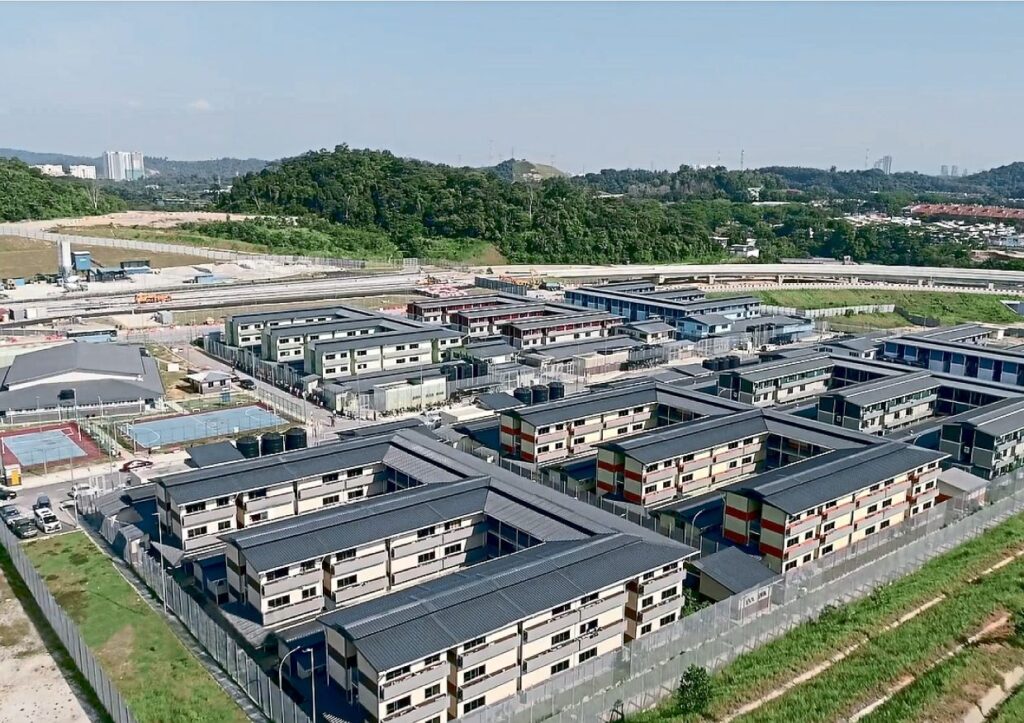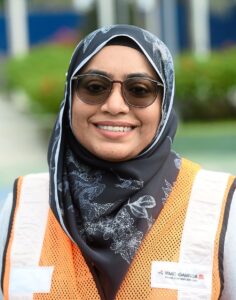Managing Covid-19 the MGJV way

As turnkey contractor in the Putrajaya MRT project including the underground works package for the over 50km-long alignment from Sungai Buloh to Putrajaya via Serdang, MMC Gamuda KVMRT (MGJV) has more than 16,000 workers under its watch.
To date, MGJV remains the only contractor to have implemented compulsory fortnightly Covid-19 screening for its workforce, using the highly accurate polymerase chain reaction (PCR) method.

What measures have MGJV initiated so far at its work sites and workers quarters?
Sirajunnisa Mohamed Farook, MGJV head of Safety, Health and Environment: We started routine mass screening in May last year with antibody test kits using blood sample collection, as well as antigen rapid test kits (RTK-Ag) using nasopharyngeal swab samples and eventually upgraded our mass screening to the PCR method.
When our own PCR lab was up and running by November, it had the capacity to process 4,000 samples daily and that is important to cater to our entire workforce of approximately 16,000 staff and workers.
To ensure that no one slips through the cracks, each personnel is assigned a unique QR code that tracks their testing records and controls their access into our work premises or centralised labour quarters (CLQs). This means anyone without a valid negative test result is automatically barred.
This is of course on top of regular temperature scanning and hand sanitisation protocols at all access points. We also ensure workers from different shifts are segregated, and those with similar skillsets or specialisation separated to mitigate against the possibility of the entire team falling sick or placed under quarantine all at once.
At our four existing CLQs which house almost 6,000 workers throughout Klang Valley, we acted fast to tighten all perimeters with controlled access and segregation.
Workers only travel between their worksites and CLQs using our dedicated transportation. Each residential block within the CLQ is isolated by physical “firewalls” which ensure no possibility of cross-infection between residents of different blocks.
And within each CLQ itself are dedicated centralised quarantine quarters blocks where those infected can be safely isolated from the rest. We have doctors on standby throughout to monitor them as well as the close contact persons. We also provide packed food to be eaten in their rooms while cooking is restricted.
MGJV also constructed a completely new Covid-resilient CLQ last year. Built in less than three months, it is a self-contained facility with all the necessary amenities to minimise the need for movements.
Our SOPs, combined with the health and hygiene standards of our CLQs which serve as effective isolation complexes for those who are asymptomatic, have given the Ministry of Health the confidence to allow these positive cases to undergo isolation within our own facilities under the supervision of medical professionals. By managing our own asymptomatic cases, we are simultaneously reducing the burden on the public healthcare system.
We now test up to 16,000 workers each cycle. In the initial stages during the baseline testing, we picked up a fair number of positive cases, which caught us slightly off guard as they were all asymptomatic.
It would be likely that the virus would have continued to spread if not for our frequent and extensive testing protocols. These personnel were duly isolated and in subsequent cycles, after careful management, we have managed to achieve a significant reduction in positive cases.
Has the PCR testing made a difference and what have you found so far?
Dr Gayathrie Sadacharamani, MGJV medical services manager: We are currently in our sixth cycle of fortnightly PCR testing, while the process of coordinating mass screenings, contact tracing and quarantine arrangement is already well-established. Data from each testing cycle (once every two weeks) has helped us refine our protocols and gauge how effective the protocols are.
The testing allows us to be one step ahead of the game, catching the cases as they come out of the incubation period (can be up to 14 days) with the results typically issued within the same day.
We found the majority of cases are asymptomatic, with fewer than 10 symptomatic cases per testing cycle. Workers who test positive will be isolated or quarantined until further test shows negative, and only released after passing MoH’s assessment. For close contacts, they will be tested on Day 5, and once more around Day 10 and only discharged from quarantine if they test negative subsequently.
How are things evolving while managing a project of this scale?
Justin Chin, executive director of Gamuda Engineering overseeing MGJV operations: Our PCR lab has been a key differentiator in managing the Covid-19 risk on the project by facilitating prompt identification, tracking and isolation of positive cases by our dedicated contact tracing teams, particularly when complemented with information technology (the QR code linked to PCR lab database). This combination has enabled us to nip things in the bud, to quickly contain any potential spread and minimise any escalation of disruption to our work.
Our newly constructed and upgraded CLQs with associated quarantine facilities have helped with segregation and accommodating the quarantine population in a low-density environment. Wherever possible, we only house one person in a room, and not more than two, at most.
Keeping to a maximum of twin occupancy promotes better psychological well-being for workers, reducing their fears with the lower density when in quarantine. This also minimises the imposition of consecutive quarantines, which can happen when quarantine is done in larger groups (when one or two within the group test positive at the end of the quarantine period).
Our approach is notably better for their mental health, as our workers really just want to get back to their normal lives as soon as possible, rather than being confined to a room for weeks on end.
We have escalated Covid-19 as the top risk of the project and our top executives have been very involved and hands-on in managing this Covid-19 risk. The results of each PCR cycle are actively reviewed and analysed to identify trends as well as evaluate the efficacy of our control measures in containing potential clusters.
Even with all these measures in place, we still have been exposed to some sporadic stoppages on the project as a result of Covid-19 which caused us some delays and increased costs. However, if we had not been so proactive with our approach, the accumulated construction delays would easily be in excess of six months.
We have had a decent run given the circumstances but we are not yet completely out of the woods. Covid-19 is a constantly evolving animal, particularly given the recent trend of heightened community cases, so we have to continuously review, refine and implement our control protocols to stay ahead of the curve and keep the project going.

